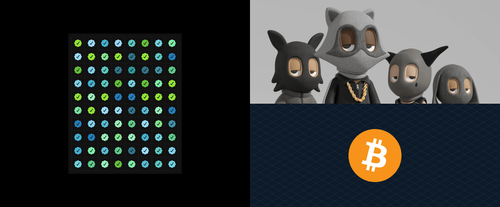BendDAO Protocol Overview
BendDAO is an NFT lending and borrowing platform on Ethereum, allowing users to gain access to liquidity through instant NFT-backed loans. BendDAO aims to become the one-stop NFT liquidity solution by not just offering liquidity on blue-chip NFTs but also integrating features such as collateral listing and NFT down payment. The protocol currently considers BAYC, CryptoPunks, MAYC, Doodles, Space Doodles, Azuki's, and CloneX as blue-chip collections.
Specifically, BendDAO utilizes a liquidity-pool-based model (also referred to as peer-to-pool) in its protocol design, the first protocol to implement this structure. In other words, lenders can provide ETH into a pool to earn interest in ETH and BEND (the native protocol token), and borrowers can borrow the available ETH by providing their blue-chip NFT assets as collateral. The collateralization ratio is 40%, meaning that borrowers can receive up to 40% of the collection’s floor price. When borrowers supply their NFT to the protocol, they receive a boundNFT, which is non-transferable, in return as their claim to the real asset. Borrowers are still eligible to receive any airdrops during the period.
BendDAO's liquidation mechanism measures the health factor of the collateral based on the collection's floor price. The floor price feeds come from OpenSea and LooksRare. The borrower is liquidated if the health factor falls below 1. The health factor is calculated as follows:
Health Factor = (Floor Price * Liquidation Threshold) / (Debt + accrued interest)
The liquidation threshold is standardized at 90%. In detail, the borrower defaults on their loan if the outstanding debt plus interest exceeds 90% of the current floor price. However, there is a 48-hour liquidation protection window to repay the debt and interest to keep ownership of the collateral.
When an NFT is liquidated (HF < 1), the asset is sent to auction during the 48-hour liquidation window, where a bidder can bid up the NFT. The bid must be:
- greater than 95% of the current floor price
- greater than the total accumulated debt
- greater than the previous bid + 1% debt
Following the auction period, the highest bidder can liquidate and take ownership of the asset. For example, if the highest bid is 95% of the floor price, the winning bidder can try to sell it on the secondary market for a 5% profit. Although once accounted for marketplace fees, royalties, and gas fees, the trade might not actually be profitable.
While this mechanism seems robust and innovative in bringing liquidity to blue-chip NFT holders, recent events state otherwise.
Current Situation
A health factor below 1.2 corresponds to a high-risk or danger zone, according to the protocol. Loans in this category are subject to liquidation if the floor price drops by 17%. On August 18, there were 45 BAYC with a health factor below 1.2.

During the time, approximately 280 BAYC and 310 BAYC assets were deposited as collateral on BendDAO alone. This equates to roughly 2.8% and 1.6% of the respective collections’ supply. The numbers have slightly reduced to 2.56% and 1.3% as of today.
The concern is that because there are a lot of assets at risk of liquidation, once the first few get liquidated, this will cause the floor price to start tumbling as other owners begin panicking about more liquidations lined up and start competing to sell their assets. Thus, this provokes more liquidation, causing a liquidation cascade. In this market condition, where the NFT volume is at yearly lows and buyer interest has dulled, there are fears that there is insufficient liquidity to support this potential unwinding.
On August 19, the MAYC floor dropped to 13 ETH and 19 assets were triggered into liquidation auctions. However, only 1 of the 13 in the auction had an active bid on it.
The day after, 3 more BAYC were put up for auction at a 66 ETH starting bid price. Again, no bidders. Why is it that no one is bidding on these NFTs below the floor?
Some possible explanations for why there is a lack of bids on these assets:
- The general NFT landscape has been muted since April and is not showing signs of recovery just yet. Buyers are generally holding off for better market conditions and confidence to return before deploying capital, even into blue-chip assets.
- The 48-hour liquidation window plays a huge role in the lack of bidders. Bidders are not willing to accept the 48-hour waiting period, where there is a risk that the value of the NFT falls even further below the bid during that window. If so, the bidder is unable to sell and will be stuck with an unrealized loss.
- The liquidation threshold is too high and not worth the risk to execute a trade. As the starting bid must be at least 95% of the floor price, the maximum arbitrage opportunity is 5% assuming that the collection's floor price remains constant.
Within 48 hours, the BendDAO WETH treasury address declined from 15,991 WETH to 15 WETH. However, the protocol still owed 14,500 WETH to the lenders, who were unable to pull their money out. As ETH is pulled from the contract, the utilization ratio of the liquidity pool naturally increases, going from 57.6% to over 86.8%. The borrow APR skyrocketed to over 55% as the mechanism tried to encourage borrowers to repay their loans and resupply the vault. The base borrowing interest rate is set at 3%.

Due to the high borrowing interest rates, some borrowers will default on their loans and keep hold of their liquidity instead (which could be beneficial for the borrower themselves as they get liquidity), leaving the protocol with the NFTs. There is a serious risk that BendDAO will accrue significant amounts of bad debt from borrowers failing to repay their loans and the value of the collateral falling below the debt accrued.
As a result, the team proposed BIP #9, which introduces the following parameter improvements:

The main purpose of the proposal was to limit the amount of bad debt that the protocol accrues from liquidations. Lowering the liquidation threshold would help ease the liquidation risks for the time being while the borrowing interest rate remains high from the high utilization ratio of the WETH treasury. Furthermore, it widens the gap between the starting bid and the floor price to a 20% spread, which is much more attractive for bidders than the 5% from a 90% liquidation threshold, along with a 4-hour auction period. Leveraging SudoSwap's instant liquidity on pools, bidders can potentially execute arbitrage opportunities with this increased spread. As more NFTs have active bids, this will allow the protocol to resupply the liquidity pool, lowering the utilization ratio and borrowing APR, limiting bad debt, and preventing more liquidations from happening. As of today, the proposal has passed.
BendDAO's WETH address has since been resupplied, with 5,000 WETH deposited earlier today. The current balance sits at 15,364 WETH (~$25.7m) and a utilization ratio of 45.53%. The situation seems to have stabilized as a result of the emergency proposal, at least for now.
Implications and impact
As a result, the BendDAO currently holds many NFTs that were liquidated from users - which serves more as a liability than an asset to the DAO. Most of these NFTs lack bids due to the mechanism surrounding the minimum bid price and the risk of buyers having to lock up their ETH for 48 hours. Furthermore, most of the minimum bid prices are higher. As of August 22, over 70% of defaulted NFTs from prominent collections such as BAYC, MAYC, CloneX, and Doodles still have no bids.
The BIP #9 proposal to adjust the liquidation threshold, auction period and interest rate passed with a large majority. This means that many more NFTs will hit BendDAO auctions beginning from August 30 when the threshold is lowered to 85%. The threshold will reduce by 5% every week till it hits 70% on September 20. A lower liquidation threshold means that even NFTs with a health factor of 1.2 - 1.3 at the moment will likely be liquidated by September 20. The health factor of NFTs on BendDAO can be tracked here.
Furthermore, the removal of having the first bid to be 95% of the floor price will be attractive for bidders as a larger deviation between bid and floor lowers the risk of non-profitability. More NFTs will definitely be auctioned off in the coming weeks, which could be a good opportunity to score blue chips at lower prices. Track NFTs available for auction on BendDAO here.
While what happened to BendDAO was an unfortunate event, it would be a good learning lesson for similar protocols to improve on such that similar events can be prevented. It would also increase the competitiveness of players in the NFT lending market, which is a positive for users. JPEGd - a close competitor of BendDAO, recently put out a proposal to offer free insurance (which would normally be 5% of debt value) for NFTs migrated from BendDAO to JPEGd. The proposal passed and any NFT migrated before August 31 will be eligible for this incentive. Therefore, protocols are constantly looking to gain market share and such events serve as a perfect opportunity for competitors to capitalize on.
Read more about the NFT lending landscape in our report here - which covers the different NFT lending models, the mechanism of each protocol as well as emerging, innovative protocols that could change the industry.
Where did BendDAO go wrong?
The current NFT lending market is still in its infancy and is certainly not optimized for its use cases. The current models that are readily available in the market have their own flaws. For instance, the BendDAO situation emphasized the lack of risk management deployed by the team, especially in a volatile market.
With BendDAO, the protocol had set the liquidation threshold/ bidding price to be at least 95% of the NFTs’ floor price and gave borrowers 48 hours to pay down loans before liquidation. This alone has driven potential bidders away from participating in the auction since the prices just weren’t attractive enough for bidders.
Bend rewards for borrowing were also highly important for bootstrapping the protocol. But given that BendDAO is already in a position where they are no longer reliant on bend rewards, there is a proposal to change lending parameters and decrease bend rewards for borrowing. The rewards are only dilutionary at this point and masked the amount of risk that borrowers are taking on from the protocol.
NFT lending at its current state is extremely risky and has many implications as laid out in the earlier paragraphs. There should be more transparency in laying out liquidation processes and specific dashboards around bad debt. This can allow users to lay out the pros and cons of borrowing/ lending.
Another proposal from a community member advises the protocol to segment lending into different pools according to risk. The current issue with the existing BendDAO lending model is the inability to price different levels of risk. At the current platform, a loan made at the maximum of 40% LTV pays the same interest as one made at 10% LTV. Even though the former is inherently riskier than the latter. One of the biggest challenges from an implementation perspective is what happens when the floor price of the underlying collateral changes.
What’s next?
With BendDAO’s new proposal, they have regained some confidence from the community. Although it seems like the issue has been solved, there are still some underlying issues in their current proposal/ execution.
- BendDAO decreased its auctioning time frame from 48h to 4h.
- Adjusted interest base rate to 20% and increased deposit APR at cost of lenders
- Old loans will be repaid
- New loans might be harder to come by since the new deposit APR is not attractive for lenders
Do note that this proposal is an interim solution that was deployed by BendDAO that served as a temporary measure. BendDAO may or may not take this as a stepping stone to recreate a new and improved model. This also opens up many doors for the discussion of peer-to-peer and liquidity-pool models and stresses new innovative NFTfi solutions in the space.







